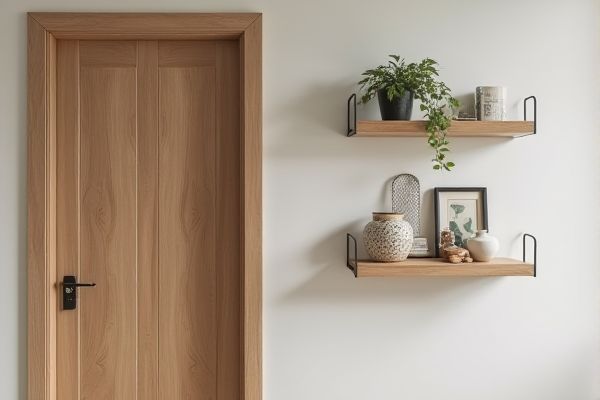
Over-the-door racks offer easy installation and accessibility by hanging directly over the top of a door, while behind-door shelves provide more stable storage by attaching to the door's back surface for heavier items. Discover which option best suits Your space and storage needs by exploring the rest of the article.
Table of Comparison
| Feature | Over-the-Door Rack | Behind-Door Shelf |
|---|---|---|
| Installation | No tools; hooks over door | Requires mounting brackets or screws |
| Storage Type | Hooks and hanging space for items like towels, bags | Flat shelves for storing folded items, toiletries |
| Space Efficiency | Utilizes top door space; minimal intrusion | Utilizes back of door; more storage surface |
| Weight Capacity | Generally lighter load capacity | Supports heavier items due to fixed mounting |
| Portability | Easy to move or remove | Fixed; not easily moved |
| Suitability | Best for hanging small to medium items | Ideal for organizing toiletries, pantry items |
Introduction to Over-the-Door Racks and Behind-Door Shelves
Over-the-door racks maximize vertical space by hanging securely over the top of doors, offering easy accessibility for organizing items like coats, towels, or kitchen utensils without altering the door structure. Behind-door shelves, installed on the door's interior side, provide discreet storage with multiple shelf layers, ideal for storing smaller essentials or pantry goods in tight spaces. Your choice depends on available space and storage needs, with over-the-door racks favoring hanging capabilities and behind-door shelves excelling in compartmentalized storage.
Space-Saving Benefits Compared
Over-the-door racks maximize space by hanging directly on the top edge of a door, freeing floor and cabinet areas without permanent installation. Behind-door shelves offer deeper storage by attaching to the door's backside, providing additional vertical layers while maintaining accessibility. Both solutions optimize small spaces efficiently, but over-the-door racks excel in quick setup and portability, whereas behind-door shelves deliver more organized, compartmentalized storage.
Installation and Setup Differences
Over-the-door racks typically require minimal installation, often hanging directly over the door without tools, making them ideal for quick setup. Behind-door shelves usually need mounting brackets or adhesive strips, which involve drilling or securing screws for stability. Your choice depends on whether you prefer an easy-to-install solution or a sturdier, more permanent storage option.
Storage Capacity and Organization
Over-the-door racks typically offer multiple hooks or bars ideal for hanging items like coats, bags, or towels, maximizing vertical storage without occupying floor space. Behind-door shelves provide more substantial storage capacity with multiple tiers or compartments, enabling you to organize smaller items like toiletries, shoes, or accessories efficiently. Your choice depends on whether you prioritize hanging space or shelf-based organization for optimal use of your door area.
Accessibility and Convenience
An over-the-door rack offers easy accessibility by hanging directly over the door, allowing you to quickly grab or store items without bending or reaching awkwardly. In contrast, a behind-door shelf provides more stable storage with multiple tiers but may require you to open the door fully and reach around it, slightly reducing convenience. Your choice depends on whether immediate access or organized capacity is more important for your space.
Durability and Material Choices
Over-the-door racks are typically made from sturdy metals like steel or aluminum, offering enhanced durability and weight capacity, making them ideal for heavier items. Behind-door shelves often feature wood or plastic materials, which can vary in resilience but provide more design versatility and aesthetic options. Your choice should balance durability needs with material preferences to ensure long-lasting functionality.
Aesthetic Appeal and Home Décor
Over-the-door racks offer a sleek, minimalistic aesthetic that blends seamlessly with modern home decor, providing functional storage without intruding on visual space. Behind-door shelves tend to have a bulkier appearance, making them better suited for eclectic or traditional interiors where visible storage complements the design. Choosing between the two depends on whether a subtle, streamlined look or a more pronounced decorative element suits your room's overall style.
Suitability for Different Door Types
Over-the-door racks are designed with adjustable hooks that fit most standard doors, making them suitable for hollow core, wooden, and metal doors without causing damage. Behind-door shelves often require installation with screws or adhesive strips, making them better suited for solid, sturdy doors that can support additional weight. Your choice depends on your door type and whether you prefer a damage-free, easily removable option or a more permanent storage solution.
Cost Comparison and Value
Over-the-door racks typically offer a more budget-friendly option with easy installation and portability, making them ideal for temporary or low-cost storage solutions. Behind-door shelves, while slightly more expensive, provide greater durability and increased storage capacity, delivering enhanced value for long-term use. Your choice depends on balancing upfront cost against the shelf's durability and storage efficiency to maximize value in your space.
Choosing the Right Option for Your Needs
Over-the-door racks offer easy installation and versatility for hanging items like towels or bags, making them ideal for limited space and quick access. Behind-door shelves provide sturdier storage with multiple tiers, suitable for organizing heavier or bulkier items such as shoes or pantry goods. Selecting the right option depends on your storage needs, available door thickness, and the weight capacity required for your belongings.
 homyna.com
homyna.com